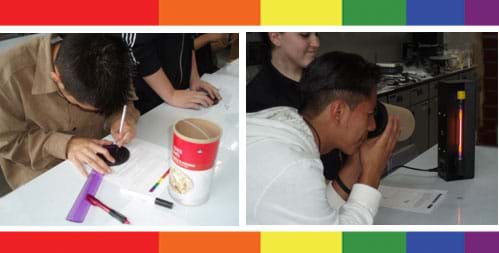
Summary
Students learn how using spectrographs helps people understand the composition of light sources. Using simple materials including holographic diffraction gratings, students create and customize their own spectrographs—just like engineers. They gather data about different light sources, make comparisons between sources and theorize about their compositions. Before building spectrographs, students learn and apply several methods to identify and interpret patterns, specifically different ways of displaying visual spectra. They also use spectral data from the Cassini mission to Saturn and its moon, Titan, to determine the chemical composition of the planet's rings and its moon's atmosphere.Engineering Connection
Spectrographs are used in ground-based telescopes and in space to help astronomers answer questions about what makes up the atmospheres of distant planets and stars. Engineers create these spectrographs to advance our knowledge of the universe. Spectrographs are designed very specifically to analyze certain types of light. The type of spectrograph materials used determines which spectral lines can be seen. Creating spectrographs to operate from space satellites is a special challenge, requiring the development of lightweight and durable materials and equipment that can withstand space travel.
Unit Overview
We recommend this eight-activity middle school unit be conducted in the following order:
- Patterns and Fingerprints
- Graphing the Rainbow
- Using Spectral Data to Explore Saturn and Titan
- Building a Fancy Spectrograph
- Using a Fancy Spectrograph
- A Spectral Mystery
- Engineering Your Own Spectrograph
- Designing a Spectroscopy Mission (this last activity is suitable for grades 10-12)
Educational Standards
Each TeachEngineering lesson or activity is correlated to one or more K-12 science,
technology, engineering or math (STEM) educational standards.
All 100,000+ K-12 STEM standards covered in TeachEngineering are collected, maintained and packaged by the Achievement Standards Network (ASN),
a project of D2L (www.achievementstandards.org).
In the ASN, standards are hierarchically structured: first by source; e.g., by state; within source by type; e.g., science or mathematics;
within type by subtype, then by grade, etc.
Each TeachEngineering lesson or activity is correlated to one or more K-12 science, technology, engineering or math (STEM) educational standards.
All 100,000+ K-12 STEM standards covered in TeachEngineering are collected, maintained and packaged by the Achievement Standards Network (ASN), a project of D2L (www.achievementstandards.org).
In the ASN, standards are hierarchically structured: first by source; e.g., by state; within source by type; e.g., science or mathematics; within type by subtype, then by grade, etc.
See individual lessons and activities for standards alignment.
Subscribe
Get the inside scoop on all things TeachEngineering such as new site features, curriculum updates, video releases, and more by signing up for our newsletter!More Curriculum Like This

Students use authentic spectral data from the Cassini mission of Saturn and Saturn's moon, Titan, gathered by instrumentation developed by engineers. Taking these unknown data, and comparing it with known data, students determine the chemical composition of Saturn's rings and Titan's atmosphere.

Students explore the outermost planets of our solar system: Saturn, Uranus and Neptune. They also learn about characteristics of Pluto and its interactions with Neptune. Students learn a little about the history of space travel as well as the different technologies that engineers develop to make spa...

Students use the spectrographs from the "Building a Fancy Spectrograph" activity to gather data about light sources. Using their data, they make comparisons between different light sources and make conjectures about the composition of a mystery light source.

Students find and calculate the angle that light is transmitted through a holographic diffraction grating using trigonometry. After finding this angle, student teams design and build their own spectrographs, researching and designing a ground- or space-based mission using their creation.
Other Related Information
The holographic diffration gratings mentioned in the Summary are available online at many websites, including Edmund Scientifics and the Rainbow Symphony Store, for ~50 cents each.
A note about terminology: In creating the Spectroscopy curricular unit, the Project SPECTRA! program chose to use the term “spectrograph” (as opposed to spectroscope) for the engineering projects activities because a spectrograph is a tool used in spacecraft and modern telescopes, and Project SPECTRA! is an astronomy program. A spectrograph uses a detector, usually a CCD (a charge coupled device, similar to those used in digital cameras), to record the properties of light. Technically, in this unit, students build “spectroscopes,“ which are similar to spectrographs, however, instead of using a detector, the human eye directly observes the light within the scope or projected onto a screen. The primary difference between the two instruments is the method in which the light is detected. A spectrograph enables a person to observe light that cannot be seen with the eye (typically ultraviolet, infrared, and x-rays) because the detector records these wavelengths electronically, enabling the signals to be observed as plots or graphs. In this curricula, when students build their “space-worthy” spectrographs, we consider the students themselves to be the detectors, and leave to their instructors the option of providing students with more in-depth explanation.
Copyright
© 2007 by Regents of the University of ColoradoContributors
Laboratory for Atmospheric and Space Physics, University of Colorado BoulderSupporting Program
Laboratory for Atmospheric and Space Physics (LASP), University of Colorado BoulderAcknowledgements
This digital library curricular content was developed with funding from Project SPECTRA!, a NASA-funded program.
Last modified: February 25, 2020







User Comments & Tips